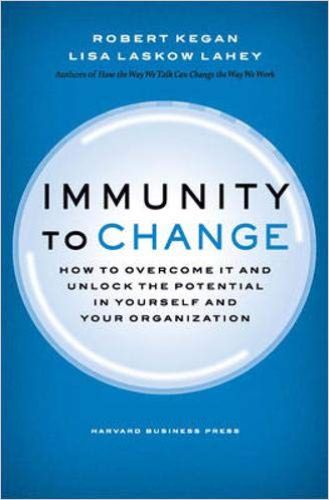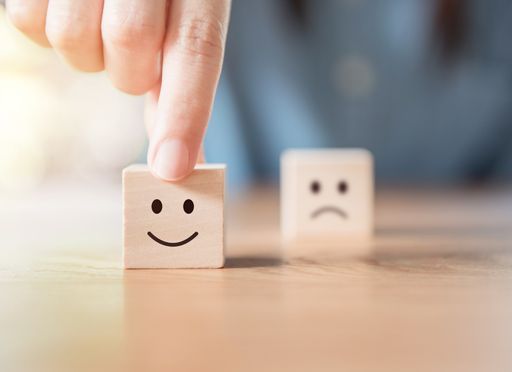A compelling recipe for personal growth and change through the simple act of self-contemplation supported by personal courage.

Get Out of Your Own Way
The core concept of this fascinating work is that people and organizations want to change, but often fail to do so because they get in their own way. Robert Kegan, a professor in Harvard’s Graduate School of Education, and Lisa Laskow Lahey, associate director of Harvard’s Change Leadership Group, delve into learning theory to provide readers with a useful framework for thinking about personal and organizational change.
Any particular expression of the immunity to change provides us a picture of how we are systematically working against the very goal we genuinely want to achieve.Robert Kegan and Lisa Laskow Lahey
The authors are perceptive about the fundamental mismatch between how people attempt to change and what they really need to do. They believe in the power of self-awareness to fuel emotional and intellectual growth, which they regard as a personal responsibility. They feel that everyone should be accountable for his or her level of emotional and perceptual maturity. However, they also urge you to remember that no true transformation happens at a steady or predictable pace. It takes time.
Roadblocks
After compassionately explaining the interior forces that keep people from following their best intentions, Kegan and Lahey provide a detailed blueprint for learning to escape the hidden roadblocks that lurk within everyone. They explain how to apply those same techniques to finding, unearthing and recovering from parallel hidden roadblocks in organizations.
The authors believe recent breakthroughs in learning theory can help you facilitate change. Until a few decades ago, most learning theories skimmed over or ignored adult development – as though people stopped changing when they matured. Kegan and Lahey detail how, over the past 30 years, numerous studies show this isn’t the case.
No matter how old you are, the story of your own development – and the stories of those around you – can continue to unfold.Robert Kegan and Lisa Laskow Lahey
The authors describe how people move from one stage to another at pivotal times when an emotionally significant experience makes them feel they reached the ceiling of their relationship to the world. At those moments, they need the support of people who care about them and are capable of providing insights into them.
In order to change yourself, Kegan and Lahey insist, you first have to understand yourself and your “emotional ecology” – or personal goals and emotional patterns. They discuss how to discern your own self-sabotaging actions. For example, Kegan and Lahey explain, when you try to lose weight, you may overeat to avoid achieving your goal. You may have, the authors reveal, a hidden commitment to displace feelings of emotional emptiness with food.
Immune System
The authors underscore that struggles over reaching your goals are not failures of willpower. Rather, they posit, your emotional immune system protects you by warding off anxiety. To move to a higher level, Kegan and Lahey explain you must discover your hidden commitments and bring them to light.
The mind-set reflected in an immunity to change is not simply a cognitive phenomenon. As we have said, it is also a brilliant anxiety-management system.Robert Kegan and Lisa Laskow Lahey
The authors believe the Myers-Briggs Type Indicator (MBTI), a personality test, helps people understand how they approach the world. Such tools, Kegan and Lahey maintain, can give team members a shared frame of reference and help them understand their individual differences as valid, alternative ways of viewing the situation.
Group Change
Kegan and Lahey teach that groups can transform collectively, starting with individual perceptions of what needs to change. Everyone experiences an organization differently, so expect considerable variation as you set comprehensive, collective goals. For example, the authors discuss the possibility of combining several individual complaints – say about communication, for example – into a single goal. The challenge is to achieve a group consensus and mutual commitment.
It is not just individuals who are in the grip of competing commitments and constraining big assumptions. Collectivities…also unknowingly protect themselves from making the very changes they most desire.Robert Kegan and Lisa Laskow Lahey
Group members also can support one another’s individual changes, Kegan and Lahey suggest. For example, if you want to learn to delegate better, focus on this goal, and assemble an internal team to observe, provide feedback and help you test your hidden assumptions.
Just be aware, they warn, change is internal and the external, that is, behavior changes minds and minds change behavior.
Articulate and Tough
Kegan and Lahey are brilliant, articulate and tough in helpful ways. Their writing is dense and multilayered. Their sentences are never academic or hard to understand, but can be long. Their message is profound, their advice is applicable, and their techniques and systems seem workable and effective. Nonetheless, you may find this is not a book to read all at once. You may benefit more from reading, absorbing and acting on one passage at a time, and then moving on to the next to profit from its often wise counsel. Kegan and Lahey’s insights will prove useful to managers and executives guiding their organizations through transformations or crises and to people who seek to remain open-minded and flexible.
Robert Kegan and Lisa Laskow Lahey also co-authored An Everyone Culture and How the Way We Talk Can Change the Way We Work. Robert Kegan’s other books include The Evolving Self and In Over Our Heads.





